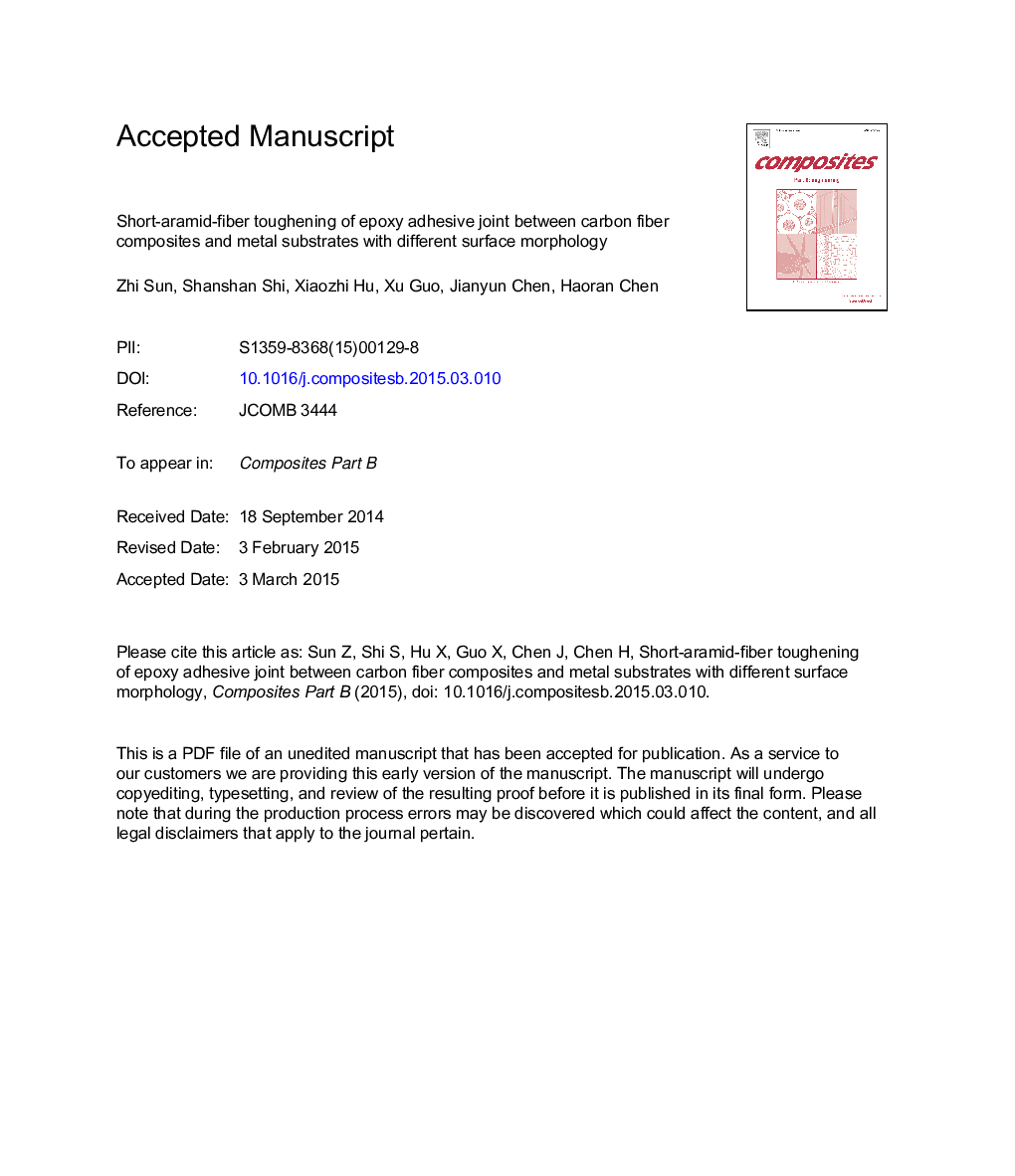| کد مقاله | کد نشریه | سال انتشار | مقاله انگلیسی | نسخه تمام متن |
|---|---|---|---|---|
| 7213064 | 1469408 | 2015 | 30 صفحه PDF | دانلود رایگان |
عنوان انگلیسی مقاله ISI
Short-aramid-fiber toughening of epoxy adhesive joint between carbon fiber composites and metal substrates with different surface morphology
ترجمه فارسی عنوان
سخت شدن فیبر کوتاه آرمید از اتصال چسب اپوکسی بین کامپوزیتهای فیبر کربن و بسترهای فلزی با مورفولوژی سطحی مختلف
دانلود مقاله + سفارش ترجمه
دانلود مقاله ISI انگلیسی
رایگان برای ایرانیان
کلمات کلیدی
ترجمه چکیده
کامپوزیت اپوکسی کربن فیبر به چهار نوع مختلف از زیربناهای آلومینیومی با زبری سطحی و به پایان رسیده است. چهار زیرگونه آلومینیومی که در این مطالعه در نظر گرفته شده است، شرایط زیر را دارند: دو زیرلایه آلومینیومی جامد که دارای دو نوع کفپوشهای مختلف و دو فویل آلومینیوم متخلخل با دو سطح مختلف سطح دریافتی هستند، یکی با یک سطح سطحی و یک براق ساختارهای منفذ علاوه بر این، اتصال دهنده های چسبنده اپوکسی نازک بین ورق های کربنی و پوشش های آلومینیومی با افزودن الیاف آرامید کوتاه تقویت شدند. در طول فرایند تولید، فیبر های آرامید کوتاه، آرامیدر، ترکیبی از بین فیبر فلزی برای ارتقاء فیبرهای پلیدی برای اتصال چسبنده و سخت تر قرار داده شدند، در حالی که در عین حال به منظور کاهش تغییرات قابل توجهی در ضخامت چسب مفصل اندازه گیری میزان انتشار انرژی بحرانی نشان داد که اثرات سخت تری از الیاف کوتاه آرمید کم چگالی تحت تاثیر زبری و پایان سطح فلز بستر قرار گرفت. مقایسه بیشتر نشان داد که چقرمگی شکنندگی بین فیبرهای آرمید-فیبر بین لایه بین لایه از طریق افزایش زبری سطح فلزات افزایش می یابد. اثر زبری سطحی بستر فلزی عمدتا به این بستگی دارد که آیا فیبرهای آزاد فیبرهای آرامید کوتاه براساس مشاهدات میکروسکوپ الکترونی اسکن شده و در حفره های سطحی زیربخش آلومینیومی قرار می گیرند. نتایج نشان می دهد که خواص و عملکرد اتصالات چسبنده بین فیبر آرمید-فیبر بین ورق های چسب کربنی و زیربن های آلومینیومی می تواند با درمان های سطحی بر روی زیر سازی آلومینیوم برای رسیدن به زبری سطح مناسب بهبود یابد.
موضوعات مرتبط
مهندسی و علوم پایه
سایر رشته های مهندسی
مهندسی (عمومی)
چکیده انگلیسی
Carbon-fiber epoxy composites were bonded to four different types of aluminum substrates with different surface roughness and finish. The four aluminum substrates considered in this study have the following surface conditions: two solid aluminum substrates polished with two different grades of sandpapers, and two porous aluminum foams with two different as-received surface conditions, one with a patterned surface finish and one with rough pore structures. Moreover, the thin epoxy adhesive joints between the carbon-fiber face sheets and aluminum substrates were reinforced by adding short aramid fibers. During the fabrication process of the hybrid laminar, sparsely-distributed short aramid fibers were inserted between the fiber-metal interface to promote bridged fibers for tougher and stronger adhesive bonding, while at the same time to minimize any significant change in the thickness of the adhesive joint. Measurements of the critical energy release rate showed that the toughening effects of the low-density short aramid fibers were influenced by the metal-substrate surface roughness and finish. Further comparison indicated that the interfacial fracture toughness of aramid-fiber interleave adhesive joints increased via increase of surface roughness of metal substrates. The surface-roughness effect of metal substrate mainly depends on whether the free fiber ends of the short aramid fibers were pressed and embedded into the surface cavities of aluminum substrates according to scanning electron microscopy observations. The results indicated that the properties and performances of aramid-fiber interleaved adhesive joints between the carbon-fiber face sheets and aluminum substrates could be improved by surface treatments on the aluminum substrates to achieve appropriately surface roughness.
ناشر
Database: Elsevier - ScienceDirect (ساینس دایرکت)
Journal: Composites Part B: Engineering - Volume 77, August 2015, Pages 38-45
Journal: Composites Part B: Engineering - Volume 77, August 2015, Pages 38-45
نویسندگان
Zhi Sun, Shanshan Shi, Xiaozhi Hu, Xu Guo, Jianyun Chen, Haoran Chen,
